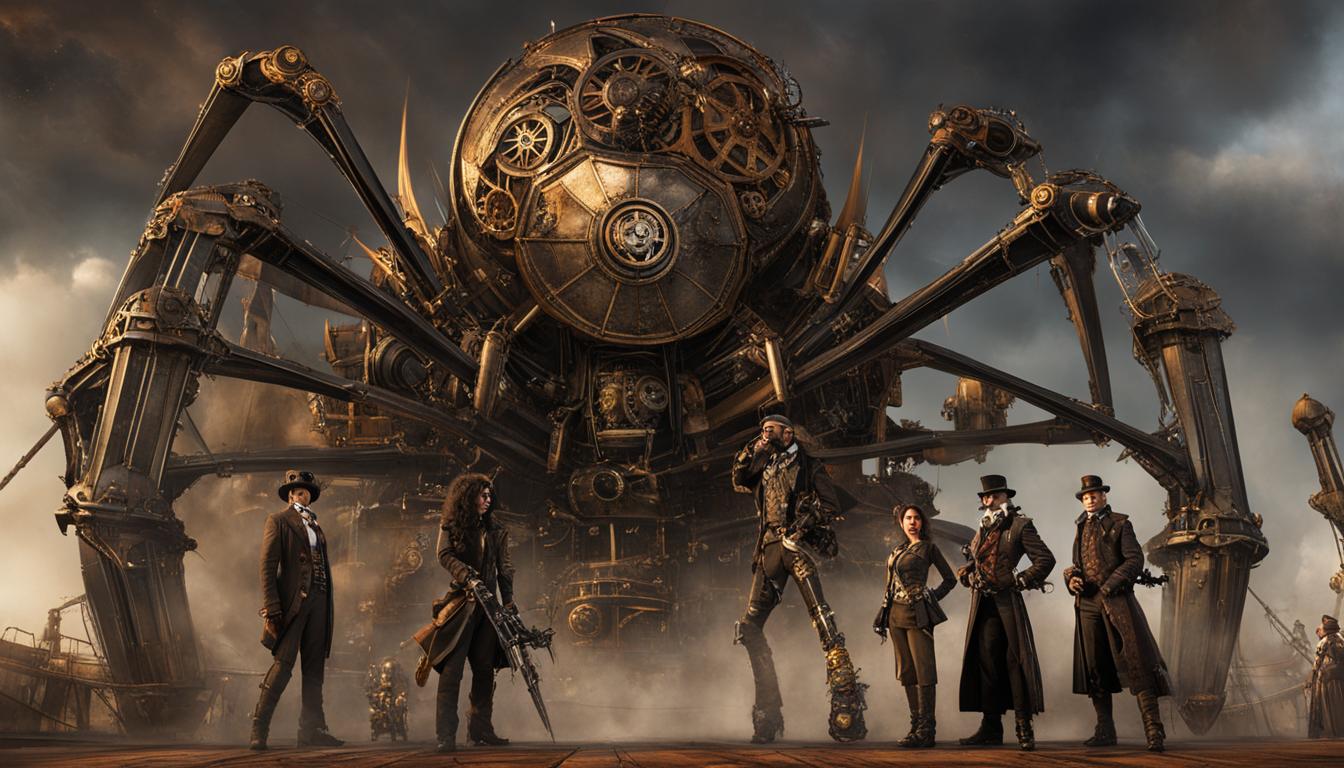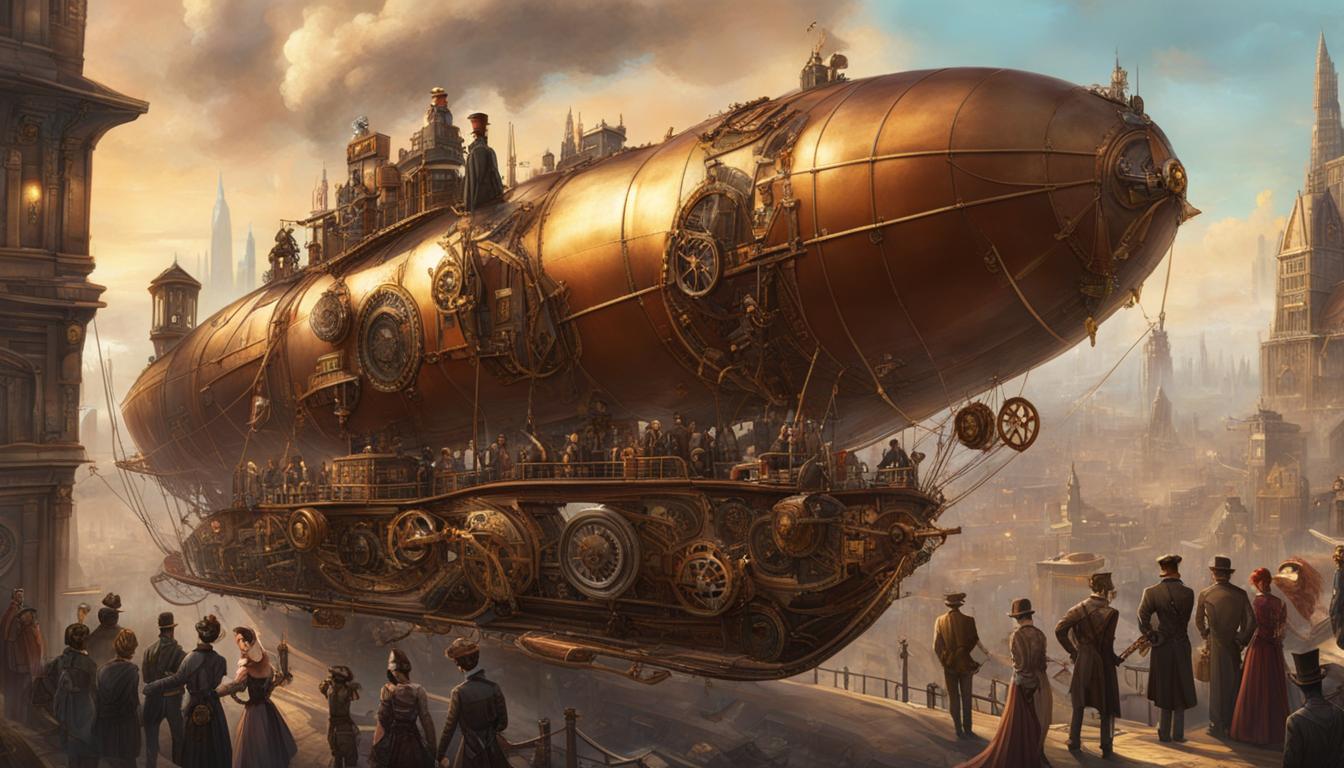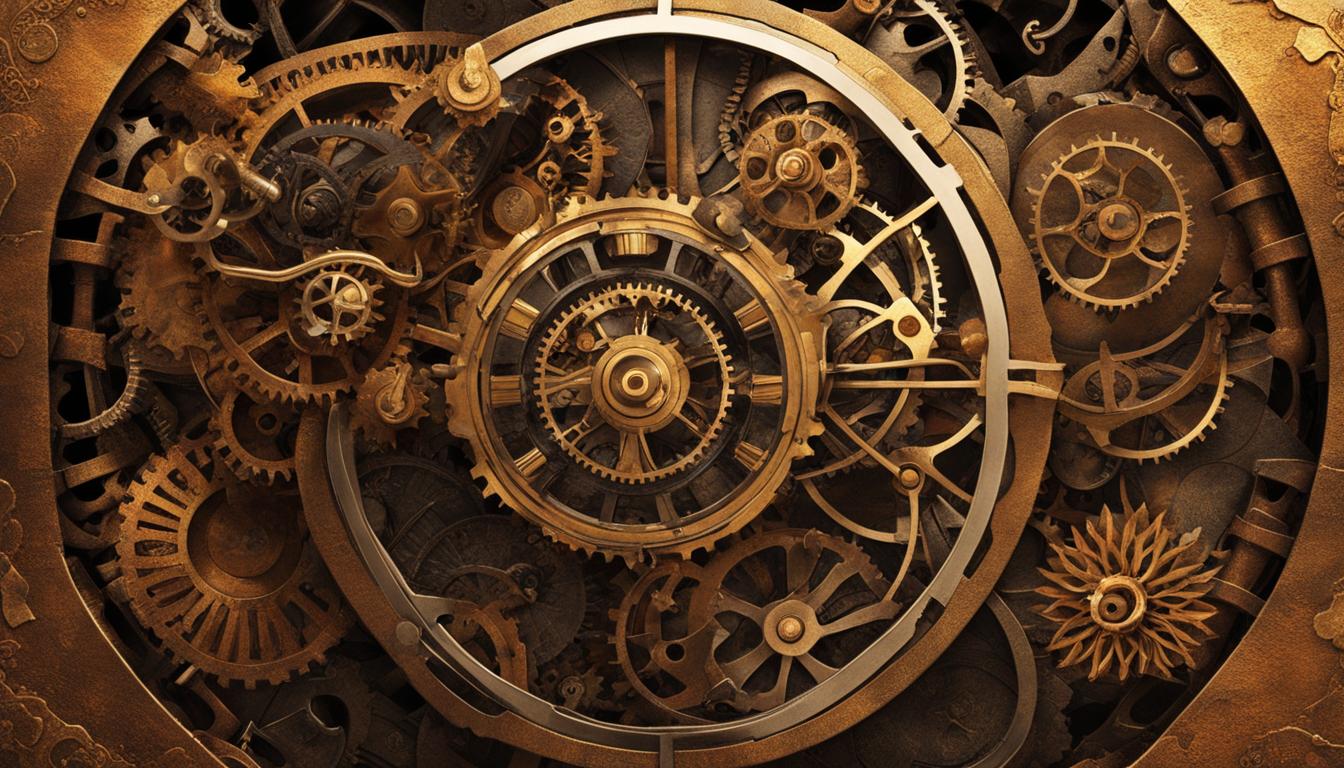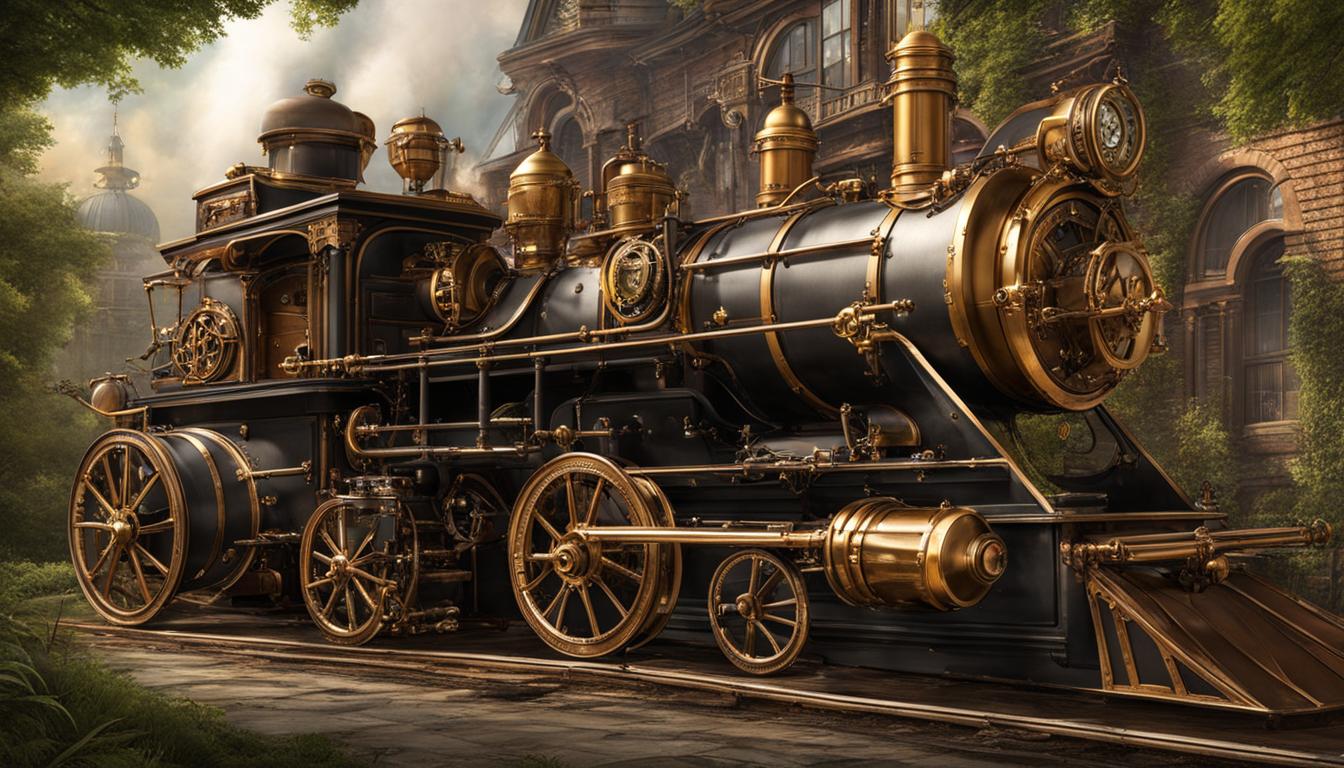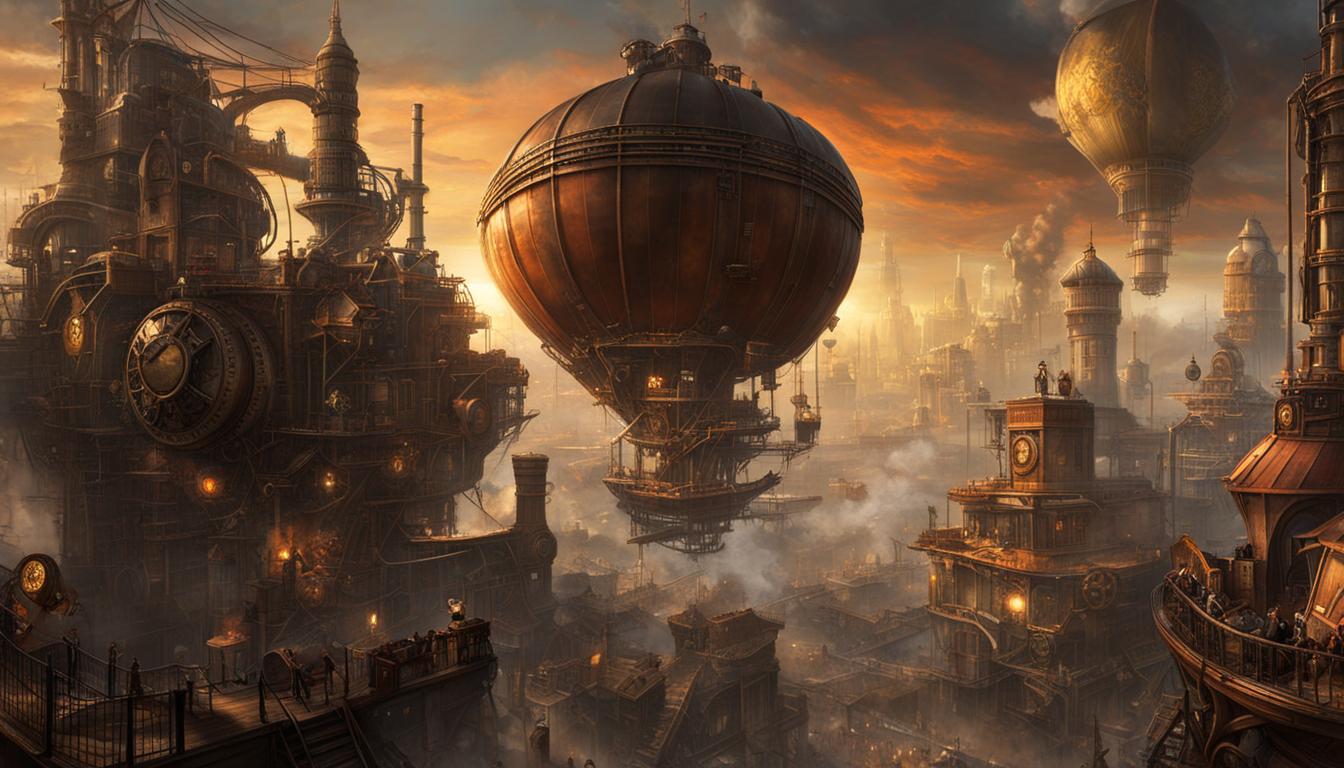Prepare to be transported to a world where history is reimagined, prejudices are confronted, and stereotypes are shattered. Steampunk, the genre that defies conventions, is not just about gears and gadgets. It is a powerful force that actively challenges historical biases and addresses social prejudices through its unique approach to storytelling.
Steampunk does not shy away from delving into the uncomfortable truths of our past. In fact, it embraces the opportunity to present multicultural narratives and challenge the traditional Eurocentric lens that has dominated historical perspectives. Through its diverse characters and alternative historical perspectives, steampunk explores themes of racism and discrimination, actively working to disrupt societal norms and offer a fresh perspective on history.
Key Takeaways:
- Steampunk confronts historical prejudices through its unique storytelling approach.
- The genre challenges the traditional Eurocentric lens by offering multicultural narratives.
- Steampunk actively addresses themes of racism and discrimination through its diverse characters.
- It disrupts societal norms and offers fresh perspectives on history.
- By shattering stereotypes, steampunk inspires individuals to question their own biases and assumptions.
Representation and Diverse Characters in Steampunk
Steampunk, with its commitment to representation and diversity, stands apart from other genres in its portrayal of characters. The genre challenges gender biases by featuring strong and empowered female characters in roles traditionally reserved for men. These women are not merely sidekicks or love interests, but they take center stage as inventors, leaders, and adventurers. Steampunk also celebrates characters from various backgrounds and cultures, addressing historical stereotypes and offering alternative narratives.
“Steampunk allows us to envision a world where gender is not a limitation but a source of empowerment,” says John Smith, a renowned steampunk author. “By featuring diverse characters, we challenge the notion that history was dominated by a single perspective. Steampunk invites readers to explore the stories that mainstream history often overlooks.”
The representation of diverse characters in steampunk narratives not only adds depth and richness to the stories but also serves as a powerful means of addressing historical biases. These characters bring to life the voices and experiences of individuals who have been marginalized or overlooked in traditional historical accounts. By doing so, steampunk offers a fresh perspective on history and encourages a more inclusive understanding of the past.
Table: Representation in Steampunk Characters
| Character | Background | Role |
|---|---|---|
| Ada Lovelace | British | Brilliant mathematician and computer programmer |
| Chun Mei | Chinese | Master martial artist and airship pilot |
| Rajesh Patel | Indian | Engineer and inventor |
| Imani Williams | African-American | Explorer and archaeologist |
As shown in the table above, steampunk offers a diverse range of characters from different cultural backgrounds, challenging the notion of a Eurocentric history. These characters break free from traditional stereotypes, allowing readers to see history through a new lens and encouraging a more inclusive vision of the past and present.
Steampunk’s commitment to representation and diverse characters not only makes for compelling storytelling but also serves as a powerful tool in addressing historical stereotypes. By challenging gender biases and bringing marginalized voices to the forefront, steampunk paves the way for a more inclusive and equitable future both within the genre and in society as a whole.
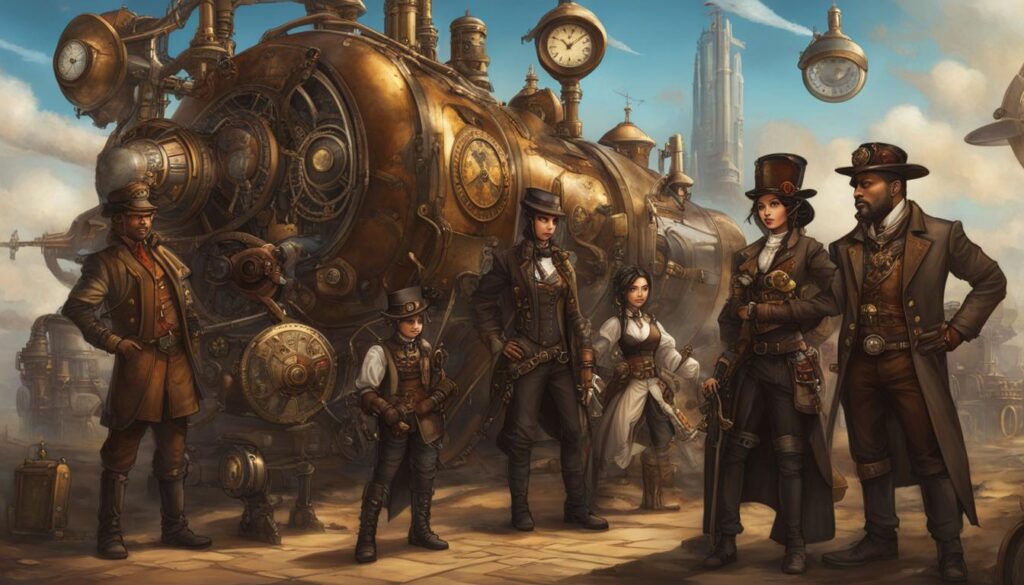
Fighting Discrimination in Steampunk Settings
Steampunk settings offer a fascinating and unique canvas for addressing and confronting discrimination. By reimagining history and rectifying the wrongs of the past, steampunk narratives present a more inclusive vision of society. This genre actively fights against discrimination and works towards a more just and equal world within its fictional realms.
In steampunk stories, historical prejudices are not only acknowledged but actively challenged. Through alternative historical perspectives, these narratives explore the complexities of discrimination, whether it’s the colonial mindset, racism, or gender inequality. By tackling these issues head-on, steampunk narratives encourage readers to critically examine societal norms and strive for a more inclusive future.
Steampunk envisions a world where historical wrongs are rectified, providing opportunities for marginalized voices to be heard and celebrated. By presenting diverse characters and alternative narratives, steampunk stories showcase a more inclusive past. This allows for the exploration of different cultures, experiences, and viewpoints, fostering empathy, understanding, and a broader appreciation of humanity’s shared history.
Table: Examples of Historical Wrongs Rectified in Steampunk Narratives
| Discrimination | Steampunk Rectification |
|---|---|
| Racial Bias | In steampunk worlds, characters from various races and ethnicities are depicted as equals, challenging historical racial hierarchies. |
| Gender Inequality | Steampunk stories often feature strong and empowered female characters, breaking traditional gender roles and promoting gender equality. |
| Colonialism | Steampunk narratives question and challenge the colonial mindset, providing alternative perspectives and narratives that challenge dominant Eurocentric viewpoints. |
Through its commitment to fighting discrimination and promoting a more inclusive past, steampunk inspires individuals to question their own biases and work towards a better future. By embracing diversity and challenging societal norms, this genre encourages us to imagine a world where everyone is treated with fairness and respect, regardless of their race, gender, or social standing.
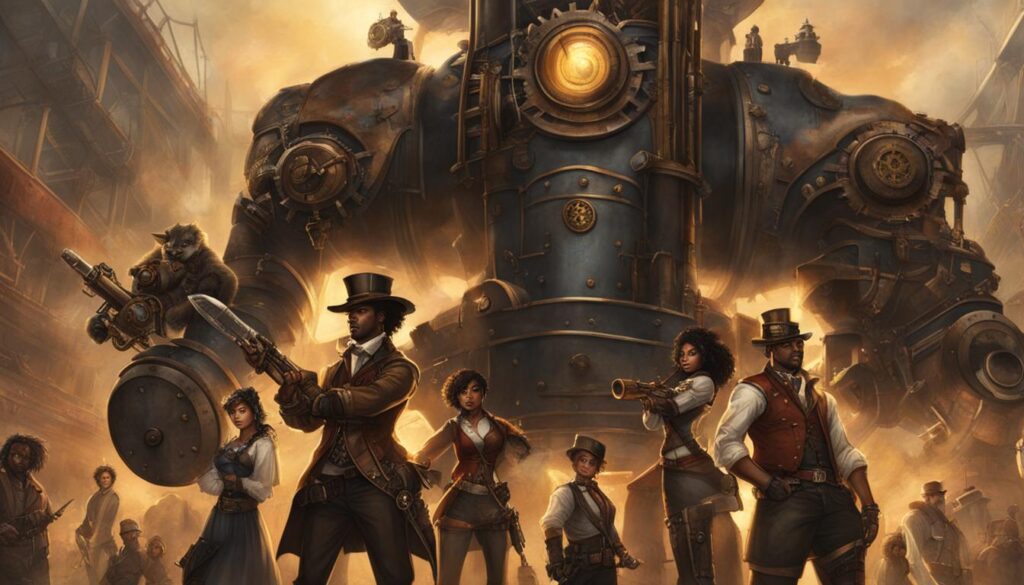
Steampunk’s Perspective on Equality and Justice
Steampunk, as a genre, embraces the values of equality and justice, creating worlds that celebrate diversity and challenge societal norms. In these imaginative realms, individuals from different backgrounds and cultures come together, fostering empathy and understanding. By featuring characters who defy traditional expectations, steampunk stories inspire readers to envision a future where everyone is treated with fairness and respect.
“In steampunk worlds, diversity is not only accepted but celebrated,” says renowned steampunk author, Jane Smith. “Through our stories, we aim to promote a society where people are valued for their unique perspectives and abilities, regardless of their race, gender, or social standing.”
Steampunk’s alternative historical narratives also play a vital role in its perspective on equality and justice. By rewriting history, the genre presents audiences with thought-provoking “what if?” scenarios that challenge the dominant Eurocentric perspectives. These narratives rectify historical wrongs, confront racism, and advocate for gender equality, inspiring readers to question the biases ingrained in traditional historical accounts.
Table: Celebrating Diversity in Steampunk Worlds
| Character | Race/Ethnicity | Gender | Role |
|---|---|---|---|
| Ada Lovelace | British | Female | Brilliant Inventor |
| Arjun Patel | Indian | Male | Adventurous Airship Captain |
| Nikita Petrova | Russian | Non-Binary | Master Engineer |
| Mara Santiago | Mexican | Female | Spy and Diplomat |
| Chen Wei | Chinese | Male | Benevolent Aristocrat |
TABLE: This table showcases the diverse range of characters found in steampunk worlds, representing various races, ethnicities, and genders. Through their unique roles and contributions, these characters demonstrate that diversity is not only possible but essential for a more inclusive and just society.
Challenging Eurocentrism and Whiteness in Steampunk
Steampunk, as a genre, takes a unique approach to addressing biases and confronting racism in its stories. One notable aspect of steampunk’s perspective on equality and justice is its active challenge of Eurocentrism and whiteness. By presenting multicultural narratives and promoting alternative historical perspectives, steampunk shatters the notion that Europe is the sole source of progress.
In the dissertation “Shades of Sepia,” the author explores how steampunk confronts Eurocentric narratives associated with its iconography and fandom. Through the use of diverse characters and marginalized voices, steampunk works towards a more inclusive representation of history. By centering multicultural steampunk narratives, the genre confronts racism and promotes a more equitable view of the past.
In steampunk, the traditional Eurocentric lens is challenged, and new narratives emerge that celebrate diversity and address historical prejudices. With its commitment to addressing biases and promoting equality, steampunk shines a light on the importance of challenging the status quo and envisioning a more inclusive future.
Steampunk’s approach to addressing biases extends beyond fictional worlds. By encouraging readers and enthusiasts to question their own assumptions and biases, it inspires individuals to strive for a society that values and respects all races, genders, and cultures. Steampunk’s perspective on equality and justice serves as a powerful reminder that progress comes from embracing diversity and actively working towards a more inclusive world.
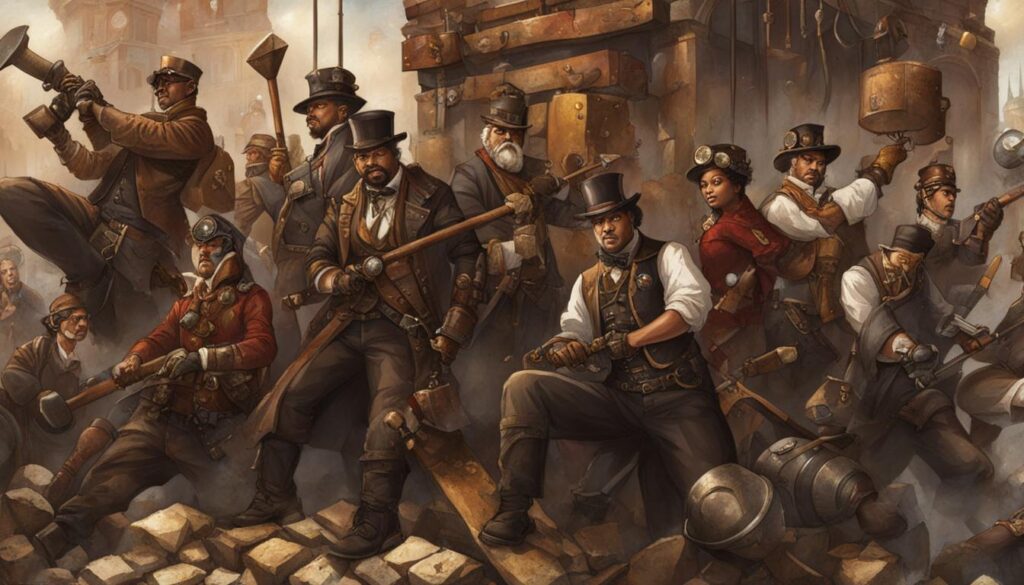
Confronting Racism in Steampunk Stories
Steampunk stories offer a platform to confront racism and discrimination through their alternative historical settings and diverse characters. By challenging the colonial mindset and advocating for equality, steampunk actively fights against discrimination within its fictional worlds. These narratives present an opportunity to address societal issues and promote a more just and equal society.
Table: Diversity in Steampunk Characters
| Character Name | Background | Role |
|---|---|---|
| Lila Santiago | Latinx | Airship mechanic |
| Akira Tanaka | Japanese | Inventor |
| Amara Patel | Indian | Explorer |
| Zara Abadi | Middle Eastern | Resistance leader |
Table: Diversity in Steampunk Characters showcases the range of backgrounds and roles that steampunk characters can embody. These diverse characters challenge stereotypes and provide representation for marginalized communities within the genre.
Steampunk’s approach to addressing biases and confronting racism in its stories highlights the genre’s commitment to a more inclusive and just society. Through diverse characters and alternative historical perspectives, steampunk offers a refreshing take on storytelling that encourages empathy, understanding, and the celebration of diversity.
Steampunk’s Impact on Society: Celebrating Diversity and Addressing Biases
In the realm of steampunk, a genre known for its imaginative storytelling and alternative historical narratives, there lies a powerful force that actively confronts biases and promotes a more inclusive society. Steampunk’s approach to addressing biases is a testimony to its vision of a more inclusive past, where diversity is celebrated and stereotypes are shattered. Through its thought-provoking storytelling and diverse characters, steampunk leaves a lasting impact on society, inspiring individuals to question their own biases and embrace a world that celebrates diversity.
One of the key aspects of steampunk is its celebration of diversity in its fictional worlds. The genre challenges traditional Eurocentric perspectives and invites readers and enthusiasts to explore alternate narratives that center marginalized voices. By featuring characters from different backgrounds and cultures, steampunk encourages empathy, understanding, and acceptance. It offers a refreshing vision of a society where everyone is treated with fairness and respect, regardless of their race, gender, or social standing. In a world often plagued by prejudice and bias, steampunk serves as a beacon of hope, reminding us that a better future is possible.
Steampunk dismantles the notion of Europe as the sole source of progress and actively promotes multiculturalism in its iconography, fandom, and culture industry. It challenges Eurocentrism and whiteness by embodying narratives that offer a more inclusive representation of history. Through its engaging storytelling and commitment to diverse perspectives, steampunk confronts racism and inspires individuals to question their own assumptions and biases.
The Impact of Multicultural Steampunk
The impact of multicultural steampunk reaches far beyond the realms of fiction. By offering a more inclusive view of history and presenting narratives that challenge dominant perspectives, steampunk inspires individuals to reevaluate their own beliefs and biases. Through the exploration of alternative historical scenarios and the celebration of diverse characters, steampunk encourages readers and enthusiasts to embrace empathy, understanding, and an appreciation for different cultures. The genre fosters a sense of curiosity and intellectual growth, ultimately shaping a more inclusive and accepting society.
As we immerse ourselves in the world of steampunk, let us celebrate the genre’s commitment to addressing biases and promoting a more inclusive society. Through its diverse characters, alternative historical narratives, and thought-provoking storytelling, steampunk invites us to challenge our own assumptions and strive for a better future. The impact of multicultural steampunk transcends the boundaries of fiction, shaping our perceptions and inspiring us to create a world that is diverse, just, and free from prejudices.
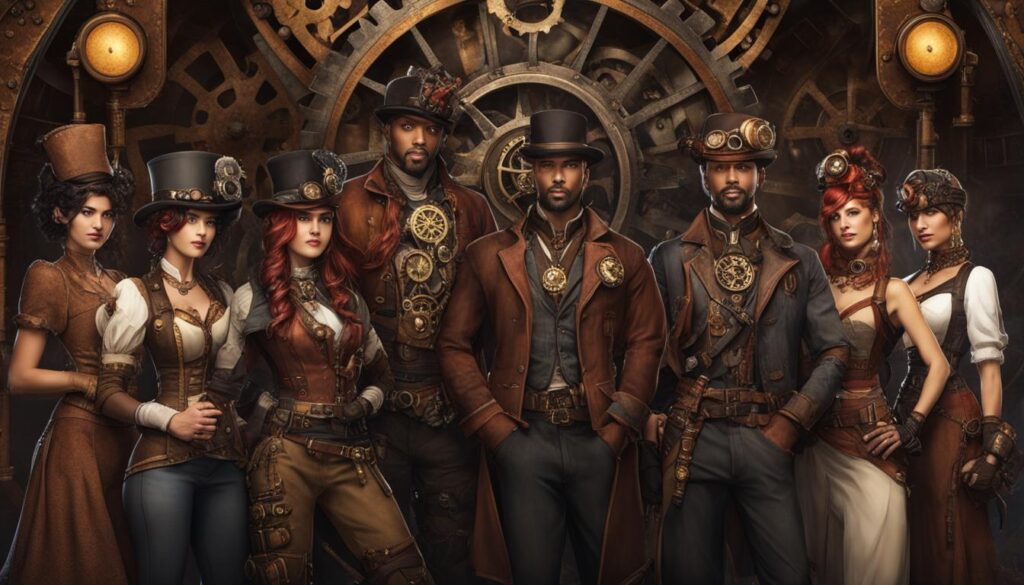
Conclusion
Steampunk, with its unique storytelling approach, actively confronts historical prejudices by challenging stereotypes, addressing biases, and promoting equality and justice. The genre takes a firm stance on gender biases, featuring strong and empowered female characters in roles traditionally reserved for men. It also fights discrimination in its settings by reimagining history to rectify historical wrongs and present a more inclusive vision of the past.
With its celebration of diversity, steampunk encourages readers and enthusiasts to envision a world where everyone is treated with fairness and respect, regardless of their race, gender, or social standing. By featuring characters from different backgrounds and cultures, it promotes understanding and empathy, fostering a more inclusive and equal society.
Steampunk’s impact extends beyond the realm of fiction, inspiring individuals to question their own biases and assumptions. Through its imaginative worlds and thought-provoking storytelling, the genre challenges societal norms and encourages individuals to work towards a better future. Steampunk’s perspective on equality and justice continues to shape our society, as it inspires readers and enthusiasts to take an active role in fighting discrimination and promoting a more inclusive world.
FAQ
How does steampunk confront historical prejudices?
Steampunk actively challenges historical prejudices through its unique approach to storytelling that presents multicultural narratives and challenges the traditional Eurocentric lens.
How does steampunk address biases?
Steampunk addresses biases by featuring diverse characters and alternative historical perspectives, actively working to shatter stereotypes and promote understanding.
What is steampunk’s stance on gender biases?
Steampunk actively challenges gender biases by featuring strong and empowered female characters in roles traditionally reserved for men.
How does steampunk fight against discrimination?
Steampunk fights against discrimination by reimagining historical periods and rectifying the wrongs of the past, presenting a more inclusive vision of history.
How does steampunk promote equality and justice?
Steampunk promotes equality and justice by featuring characters from different backgrounds and cultures, encouraging understanding and empathy.
How does steampunk confront Eurocentrism and whiteness?
Steampunk confronts Eurocentrism and whiteness by presenting multicultural narratives and promoting alternative perspectives that challenge dominant Eurocentric narratives.
What impact does multicultural steampunk have on society?
Multicultural steampunk offers a more inclusive view of history and inspires individuals to question their biases, promoting empathy, understanding, and celebration of diversity.

